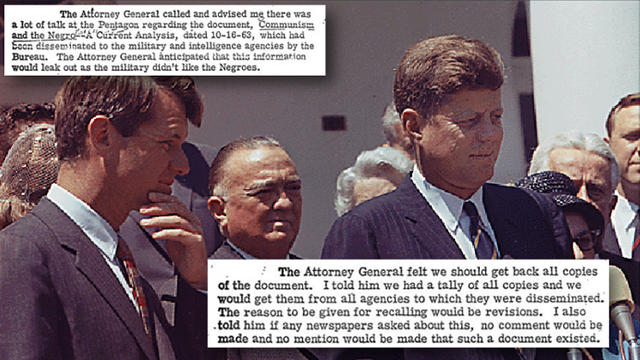
IT HAS ALREADY been proven in court that a conspiracy involving the US Federal Government was behind the 1968 assassination of Dr Martin Luther King Jr. This Steemit post is not going to re-hash the work that went into reaching that historic verdict. What has not been shown before is how that 1968 conspiracy came together. I can now demonstrate at least part of that process to -- I hope -- your satisfaction.
Surprisingly, there is a bureaucratic paper-trail to the whole affair, which has been overlooked until now. And more surprisingly still, it starts in 1963. This is five years before Dr King was murdered, and while President Kennedy and his brother Robert were still alive and in office. The White House photo seen above shows the brothers, while FBI Director J Edgar Hoover -- fittingly -- lurks in the background.
The key to understanding what you're about to read is the word "incitement."
October 15, 1963
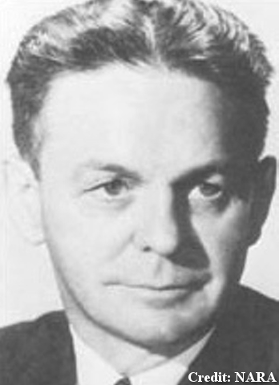
FBI INTELLIGENCE Operations chief William C Sullivan (pictured left) disseminates a memo. In it, he announces the completion and imminent circulation of a dossier entitled "Communism and the Negro Movement - A Current Analysis." The contents are described in rather general terms.
At first glance, you'd take it as just another of those alarmist memos that periodically did the rounds in Washington DC during the Cold War.
But this is worth a closer look. Sullivan is evidently so pleased with what he has created that he intends to circulate it to a pretty exclusive circle of the powerful.
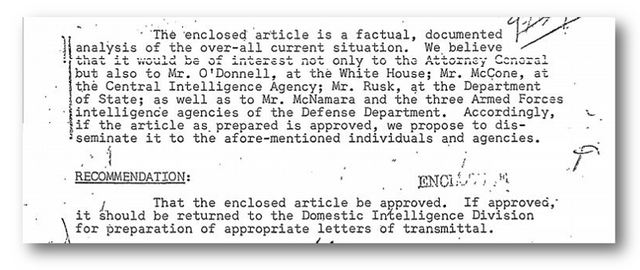
You might be wondering about Sullivan's private attitudes towards Dr King. Later, in 1964, W C Sullivan was one of the evil geniuses who executed the infamous blackmail-suicide exercise against MLK, in which tapes of (married) Dr King with other women were sent to the Kings' address with poison pen letters telling MLK to kill himself to avoid exposure.
October 17, 1963
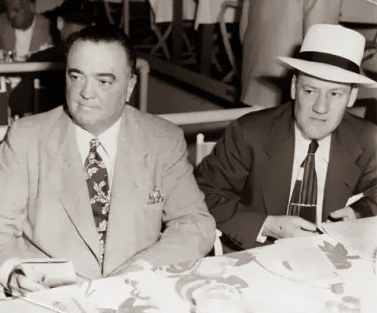
ASSISTANT FBI director Alan Belmont writes to FBI associate-director Clyde Tolson. Tolson was also Hoover's lifelong companion, and they were rumoured to be lovers (pictured together, right). Belmont is apparently concerned by Sullivan's memo and the accompanying dossier on communism and "negroes."
Rather indiscreetly, Belmont blows Sullivan's cover-story for the dossier. What Sullivan has actually created is a "dirt sheet," intended to paint Dr King as a communist subversive intent on undermining the USA.
In the extract pictured below, you can see that Belmont remarks that the Attorney-General (Robert F Kennedy) is going to be pretty startled. Belmont would soon be proved correct -- but not in the way he expected.
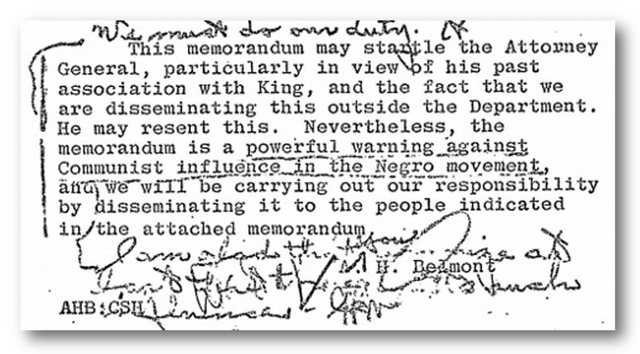
It's hard to understand why Belmont (the FBI's "Number 3") put this in writing, and even harder to understand why he sent it to Tolson (the FBI's "Number 2"). The feel of the incident is that Belmont was himself pretty shaken by the dossier (which he describes as "highly explosive") and wanted to let Hoover know without provoking him directly. So it looks like Belmont was using Tolson as a go-between, trusting him to break it to Hoover with the right degree of sensitivity.
October 25, 1963SULLIVAN'S DOSSIER was circulated, as intended, and everything went quiet for a week or so. Now, out of the blue, Robert F Kennedy calls FBI Director J Edgar Hoover. Hoover hated the Kennedys, and the feeling was mutual, so this was no friendly catch-up. In fact, wild horses would not have dragged RFK to deal with Hoover unless it was of the utmost importance.


There is a touch of "poker" to this conversation. RFK tells Hoover that Sullivan's dossier is causing some debate at the Pentagon, and now that he's aware of that debate RFK is getting alarmed.
RFK doesn't show his hand to the hated Hoover, and doesn't express an opinion about Sullivan's dossier.
Instead, RFK carefully uses a cover-story of his own, claiming that he is concerned that someone at the Pentagon will leak Sullivan's memo, because "the military don't like the negroes."
Kennedy (pictured with Dr King, above right) demands that Hoover issue a recall notice for the Sullivan dossier, to get back every single copy that had been disseminated. So, RFK wasn't concerned about just the Pentagon.

THE SULLIVAN DOSSIER on MLK was snatched back from most of its recipients, and everything went quiet again. Most of them, but not all. As you can see from the excerpt below, it was noted at the time that President Kennedy didn't return his copy (which had been sent to his advisor Ken O'Donnell), and nor did Robert Kennedy or his heads of staff.

What were the Kennedys up to? A rational inference would be that they were hanging on to their copies of the dossier as potential ammunition in their ongoing private war with Hoover.
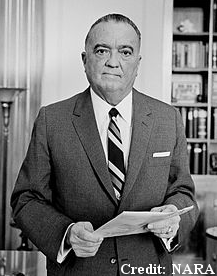
RFK and Hoover were both clearly stewing over this episode, because now (more than a week after calling him), RFK turns up in person at Hoover's office and there is an ice-cold argument. Afterwards, Hoover (pictured right) sits and drafts a memorandum of RFK's visit.
It looks like this memo was for Hoover's own records as much as it was for the memo's stated recipients (who, you will note, include W C Sullivan). You have to treat it with a little scepticism, because of the Hoover-Kennedy hatred. But there's nothing in it that rings immediately false, and quite a lot that sounds very plausible. In particular, the following passage, in which Hoover records how RFK tried to deny even having seen the dossier.

No doubt with a thin-lipped smile of satisfaction on his face, Hoover notes how he politely but firmly squelched RFK's "alibi" by pointing out that RFK had received a copy at the same time as all the other recipients. It seems RFK didn't have a good answer to that one.
Interlude: An Uneasy Truce
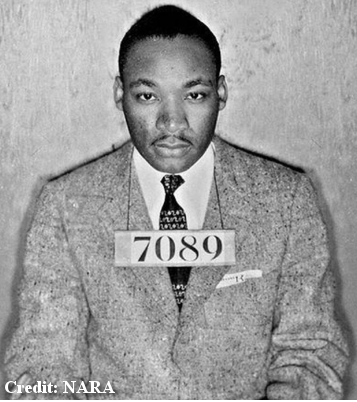
WHAT HAD HAPPENED during the Autumn 1963 dossier episode was that a key FBI man had effectively created a "cabal" who were now aware of the FBI's reasons for believing Dr King to be a communist. This was a case of "light the blue touchpaper and stand well back."
The fact that RFK was alarmed by rumblings from the Pentagon shows that Sullivan had succeeded.
What Sullivan had really done was to provide a list of reasons for getting rid of Dr King (pictured above left) but left the decisions to people with the capacity to carry it out. In a word, it was incitement.
In any event, by this stage in 1963, JFK had a fortnight to live, and an incendiary dossier compiled by a man (W C Sullivan) who wanted Dr King dead had been sent to some of the highest figures in Government. The panicking RFK was keen to distance himself from the document, giving a flimsy excuse for ordering the recall ("leak prevention") and then attempting to deny that he had even seen it. But the fact that neither of the Kennedy brothers returned their copies shows that they had read the dossier and had determined its potential for use against Hoover (rather than against King), and were therefore keeping their ammunition dry.
For the moment, it must have seemed like the Kennedys had won this particular battle. The Sullivan dossier on Dr King disappeared from the official record. But it would reappear after JFK's death.
Part 2 of this story was published June 22, 2018 - read it here
You can read my story about Britain's role in the MLK cover-up here
⦿ All Rights Reserved